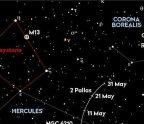BULLETIN

Galactic relic discovered in Milky Way
Remains found from a galaxy that merged with ours billions of years ago
A ‘fossil galaxy’ has been identified hiding in the heart of the Milky Way thanks to a campaign that’s observing over half a million stars. The galactic relic, which astronomers dubbed Heracles, was once a separate galaxy but collided and merged with our own Galaxy around 10 billion years ago.
Heracles was discovered using the Apache Point Observatory Galactic Evolution Experiment (APOGEE), which has been tracking stars across the Milky Way. As the instrument looks at infrared light it’s able to pick out stars in the dusty galactic core that are usually obscured from view.
“Of the tens of thousands of stars we looked at, a few hundred had strikingly different chemical compositions and velocities,” says Danny Horta, who led the study. “These stars are so different that they could only have come from another
You’re reading a preview, subscribe to read more.
Start your free 30 days





